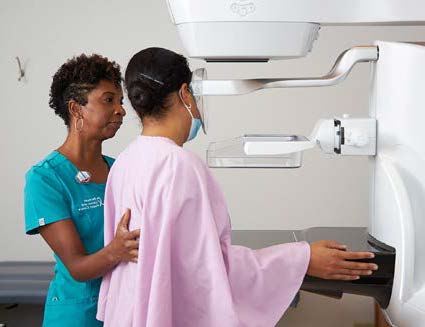By Erin Silver
It was a year in which front-line health-care staff worked overtime to support Bermudians through one wave of COVID-19 after another. Many of the dedicated experts who work behind the scenes to care for Bermuda’s cancer patients rarely get the spotlight. Here however, we meet Rona Donawa, Chief Imaging Technologist who oversees the mammography, ultrasound and bone density departments as well as breast and prostate biopsy services at the Bermuda Cancer and Health Centre (BCHC). Donawa has worked at the centre since 2009, becoming chief technologist in 2015.
Royal Gazette: Describe the Diagnostic Imaging Department. How many staff are you and how many patients do you see a year?
Rona Donawa: We have three full-time receptionists, five staff technologists, one chief imaging technologist, one transcriptionist and one radiologist. We see approximately 9,000 patients a year, and this includes conducting mammograms, bone density scans and ultrasound exams.
RG: Why did you want to specialize in cancer?
RD: I worked alongside Dr. David Dyer in his dental practice. There I discovered xrays and this directed me into Radiology. From my early college years I knew that I enjoyed helping others. Health care seemed like the right fit for me. I have enjoyed imaging as it is a direct way to help physicians with diagnosis.
RG: What’s the most rewarding part of your job?
RD: The most rewarding part of my career is developing trusting relationships with our patients and supporting them when they feel the most vulnerable. Providing encouragement and reassurance means a lot to me. To be requested as someone’s health-care partner is the ultimate compliment.
RG: What’s the most difficult part of your job?
RD: It is always difficult when a new diagnosis is made. It is such a difficult time for patients, and despite doing all that you can, you never quite feel as if it’s enough.
RG: How did COVID impact your workplace and patients over the last year?
RD: COVID brought many changes, including reduced schedule and spaced waiting areas to ensure social distancing. Our doors remain locked and we also have a screening process that we conduct with each patient and member of staff before they enter the building. Staff are required to wear appropriate levels of PPE to ensure protection at all times. We have always cleaned our equipment after each exam, therefore this is not a new process for us, but we now have extended that to the changing and waiting rooms as well. We want to ensure the safest environment to our clients, staff and our vulnerable patients who are in the midst of radiation treatment and whose immune systems may be compromised. Our entire health-care team is committed to serving our clients and making them feel comfortable even during these challenging times.
RG: Do you have any memorable good news stories to share?
RD: Overall, we each love what we do and all go the extra mile to assist where we can. Sometimes it’s obtaining previous images and reports, other times it’s sending images and reports to other facilities, sometimes it’s working to get an urgent report. We are not an urgent- care facility, but we recognize that critical cases require a quick report turnaround time that can provide a patient with timely news so they can be assured they are in good hands.
RG: What motivates you to do your best each day?
RD: I take pride in what I do. I love being able to help and make others feel better even when faced with unfortunate circumstances. I live by the motto, “treat others as you would like to be treated” and that seems to work for every encounter. No one signs up for cancer or any illness for that matter. The very least I can do is to be kind and helpful. I feel it is my duty as a health-care professional.
RG: Are there any exciting developments in cancer care that you can share?
RD: Imaging technology is evolving at a rapid pace. Staying current is important but also a challenge as the costs of technology continue to increase. At BCHC, we keep up to date with breast screening equipment. We are pleased to be able to offer 3D mammograms for our clients on the GE Prisitna, one of the newest technologies available for breast screening. We are always on the lookout for new methods and developments that we feel are beneficial to the community.
RG: Do you have any advice for Bermudians who are hesitant to get checked, who have been touched by cancer or perhaps want to get involved in raising funds for the centre?
RD: Breast cancer is over 95 percent treatable, when found early. Despite what one may hear, mammograms are still the best way to detect early stages of breast cancer. BCHC hosts many fundraising events each year. Although COVID has challenged us in this area, the need is still there, so successful fundraising is as important as ever. Many people in our community have lost jobs and insurance coverage. We believe that everyone is entitled to health care, whether they can afford to pay or not. Fundraising events help cover the costs for these patients.

